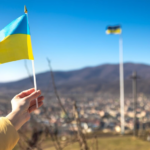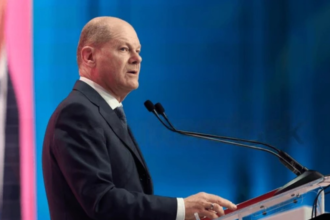On Saturday, crowds of demonstrators assembled in cities throughout the United States on what would turn out to be the biggest national rally against President Trump since he took office in January. Under the “Hands Off” movement, the anti-Trump demonstrations sought to host rallies in more than 1,200 sites, spanning all 50 states and reaching globally to cities including London, Paris, and Berlin.
- What set off the worldwide Protests?
- In what ways has immigration enforcement targeted students?
- What Message Do Washington DC Protesters Send?
- How did the President respond to the widespread demonstrations?
- About the Protests, What Are Trump Allies Saying?
- Are public opinion changes reflected in the protests?
- This implies what moving ahead?
Tens of thousands of people showed up in big cities, including Boston, Chicago, Los Angeles, New York, and Washington, DC. From economic disparity and foreign policy issues to immigration enforcement and social fairness, the complaints expressed covered a broad range of President Trump’s domestic and international agenda.
What set off the worldwide Protests?
Though centered on American concerns, the anti-Trump demonstrations had global repercussions. Following Trump’s declaration that most of its American trade partners will face import taxes, protest organizers overseas reflected the attitude of their counterparts back home.
Protesters carrying placards stating “WTAF America?” “Stop hurting people,” and “He’s an idiot “were chanted in London. Concerns about Trump’s increasingly forceful foreign policy—including provocative comments regarding the annexation of Greenland and Canada—were voiced by many participants. Central London heard chants of “Hands off Canada,” “Hands off Greenland,” and “Hands off Ukraine.”
“We are here to show solidarity with Americans,” a Berlin demonstrator said. Trump’s policies harm world relations, not only those of the United States. Paris, where many protestors expressed annoyance at Trump’s involvement in postponing peace negotiations between Ukraine and Russia and the government’s lack of backing of long-standing partnerships, reflected this attitude.
In what ways has immigration enforcement targeted students?
The recent series of immigration raids targeting overseas students was one of the flashpoints aggravating the anti-Trump demonstrations. The story of Rumeysa Ozturk, a Turkish student studying close to Tufts University, attracted internet notice in Boston. Social internet was ablaze with indignation at video footage of her being taken under cover federal officials.
Attending the Boston rally, law student Katie Smith remarked, “You can stand up today, or you can be taken later.” She said, ” Usually a protest chick, this exceeded the line. Here, legally, Rumeysa was building a future.
Many of the protestors in many different cities now feel insecure attending American institutions; they echoed Katie’s worries and demanded more compassionate immigration enforcement and clearer protections for international students.
What Message Do Washington DC Protesters Send?
One of the biggest turnout Washington DC seen was thousands of people gathering close to the National Mall to hear speeches from Democratic legislators and leaders of civic society. Opposing the rising power of billionaires inside the government—especially those of Elon Musk, who advises President Trump—was a central motif.
Speaking fervently, Florida Congressman Maxwell Frost attacked what he referred to as the “billionaire takeover of our government.” “When you steal from the people,” he advised the gathering, “you should anticipate the people to rebel. At the sstreet andthe ballot box.
Theresa, one of the demonstrators, claimed she was there out of concern over the direction public services were headed. She declared, “We are losing our democratic rights.” The cuts they are making to the federal government greatly worry me. Retirement, education, healthcare—all seems to be on the chopping block.
She also questioned whether the demonstrations would grab the president’s interest. Let’s see, then. He has been golfing practically daily.
How did the President respond to the widespread demonstrations?
Regarding the anti-Trump demonstrations over the weekend, President Trump mostly said nothing. He was seen golfing at a Florida resort he owns and had no public activities. His calendar has him scheduled for golf on Sunday once more.
Later, the White House issued a defiant statement claiming that President Trump stayed dedicated to safeguarding Social Security, Medicare, and Medicaid. The comment then blamed Democrats for suggesting perks for illegal immigrants, therefore endangering these important programs.
“President Trump’s posture is clear: he will always protect Social Security, Medicare, and Medicaid for eligible beneficiaries,” the statement said. The Democrats’ position is allowing illegal immigrants to get Social Security, Medicaid, and Medicare benefits, therefore undermining American elderly and bankrupting these programs.
About the Protests, What Are Trump Allies Saying?
Not every administrative official remained silent. One of Trump’s best immigration advisers, Tom Homan, spoke on the demonstrations in a TV interview. Though he was in Washington at the time, he said that several protestors had assembled outside his New York house.
“They can demonstrate a vacant house all they want,” Homan added. Rallies and demonstrations have no meaning whatsoever. So, go ahead and use your First Amendment rights. It will not alter the evidence in the case.
Homan also attacked the waste of police resources, alleging that the demonstrations “tied up” law enforcement personnel who could have been addressing more urgent problems.
Are public opinion changes reflected in the protests?
The anti-Trump demonstrations coincide with evidence of popular opinion perhaps changing. Republicans prevailed in a widely watched special congressional election held in Florida, although by a thinner margin than expected. In a state Supreme Court contest in Wisconsin, a Democratic judge defeated a Republican candidate supported by Musk by almost 10 percentage points.
Polls imply mounting discontent with the government. Earlier in the week, a Reuters/Ipsos poll showed Trump’s approval rating had dropped to 43%, its lowest point since he took office. Just 37% of respondents agreed with his economic performance, and only 30% backed his strategy for addressing the growing cost of living.
Another Harvard Cap/Harris survey found that his approval dropped from 52% to 49% in just one month. Still, 54% of respondents felt Trump is doing better than Joe Biden did during his presidency.
This implies what moving ahead?
Although it’s unknown if the anti-Trump demonstrations will immediately result in political change, they have surely motivated a lot of people. The scope and worldwide presence of the movement point to a general and mounting discontent with the way the nation is headed under Trump.
The streets have spoken loudly; now, the issue is whether their voices will carry into the next laws, elections, and the larger political discourse. For many, Saturday’s huge demonstrations mark only the start.







